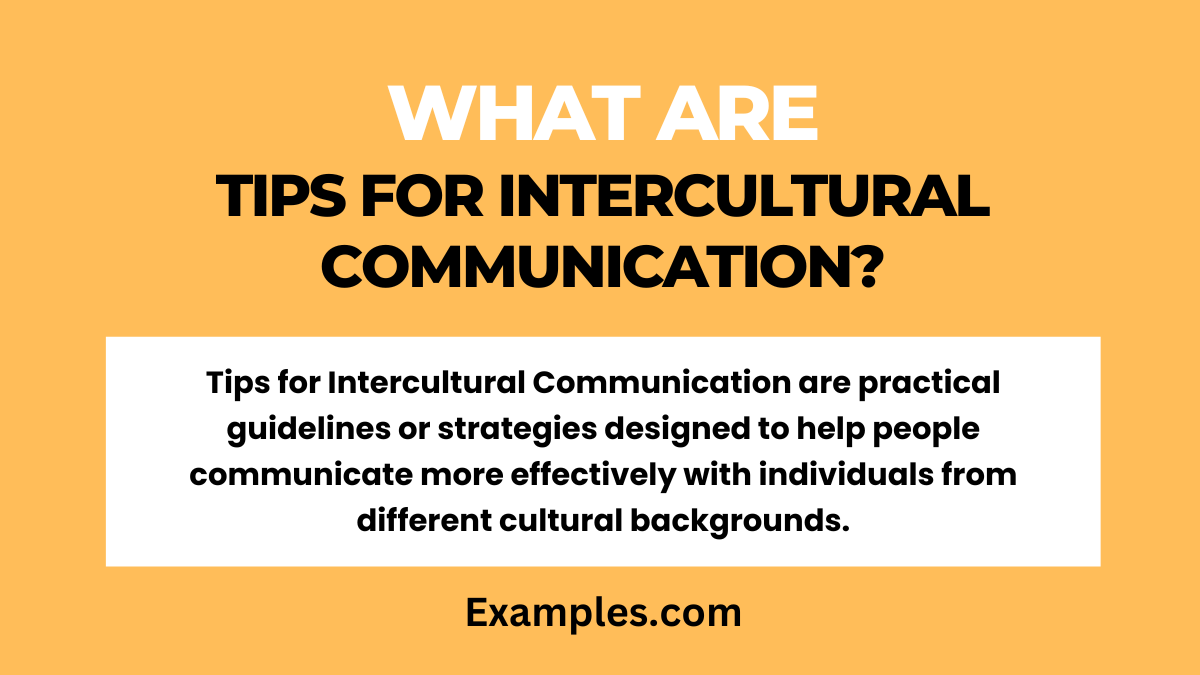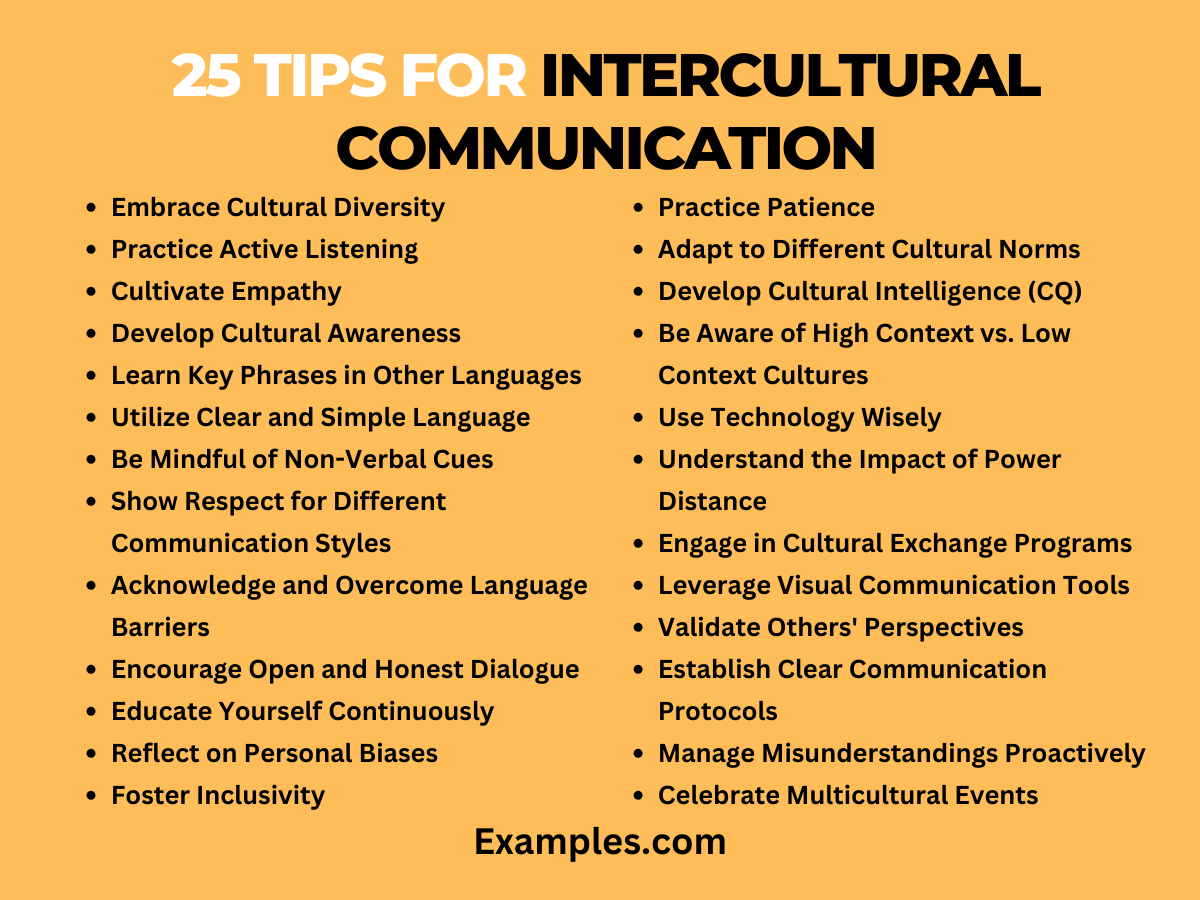Tips for Intercultural Communication – Examples, Tips
Navigate the complexities of global interaction with our comprehensive guide on Tips for Intercultural Communication. This resource is packed with practical advice and Intercultural Communication Examples to help you effectively communicate across cultural boundaries. Whether you’re engaging in international business, education, or personal relationships, these tips will empower you to overcome cultural barriers and foster understanding and cooperation in diverse environments.
What are Tips for Intercultural Communication?

Tips for Intercultural Communication are practical guidelines or strategies designed to help people communicate more effectively with individuals from different cultural backgrounds. These tips focus on improving understanding, respect, and empathy in interactions between people of diverse cultures. They often include advice on how to be aware of and sensitive to cultural differences, adapt communication styles, understand non-verbal cues, and overcome language barriers. The goal of these tips is to reduce misunderstandings and enhance collaboration in a multicultural environment.
25 Tips for Intercultural Communication
In the globalized world of today, mastering Intercultural Communication is more important than ever. This guide presents 25 essential tips to enhance your ability to communicate across cultural boundaries. Each tip is designed to help you navigate the complexities of intercultural interactions, whether in business, education, or social settings. These strategies will equip you with the skills to understand, respect, and effectively engage with people from diverse cultural backgrounds, fostering more meaningful and productive communication.

1. Embrace Cultural Diversity: Recognize and appreciate the richness that different cultures bring to any interaction. Celebrating diversity goes beyond tolerance; it involves actively learning about and valuing other cultural perspectives.
Example: Attend cultural festivals or workshops to gain firsthand experience and appreciation of different cultures.
2. Practice Active Listening: Active listening is essential in intercultural communication. It involves fully concentrating on the speaker, understanding their message, and responding thoughtfully.
Example: In conversations, repeat back what you’ve heard to ensure you’ve understood correctly, and ask clarifying questions if necessary.
3. Cultivate Empathy: Empathy helps bridge the gap between different cultural perspectives. It involves understanding and sharing the feelings of others.
Example: When interacting with someone from a different culture, try to put yourself in their shoes and understand their point of view.
4. Develop Cultural Awareness: Being aware of your own and others’ cultural backgrounds and biases is crucial. This awareness can prevent misunderstandings and foster smoother communication.
Example: Research cultural norms and practices before engaging with people from a different culture.
5. Learn Key Phrases in Other Languages: Knowing basic phrases in another language can be a sign of respect and effort in communication.
Example: Learn greetings and common courtesies in the language of your international colleagues or friends.
6. Utilize Clear and Simple Language: In intercultural communication, it’s important to use clear, simple language to avoid misunderstandings.
Example: Avoid slang, idioms, and complex vocabulary when speaking with non-native speakers.
7. Be Mindful of Non-Verbal Cues: Non-verbal communication can vary significantly across cultures. Pay attention to gestures, facial expressions, and body language.
Example: Research common gestures in different cultures to avoid misinterpretation.
8. Show Respect for Different Communication Styles: Different cultures have different styles of communication. Some may be direct, while others are more indirect.
Example: Adapt your communication style to match or complement the style of the person you’re communicating with.
9. Acknowledge and Overcome Language Barriers: Language barriers can be a significant challenge in intercultural communication.
Example: Use translation tools or services if necessary, and be patient in conversations.
10. Encourage Open and Honest Dialogue: Creating an environment where open, honest communication is valued is important in fostering understanding.
Example: Invite open discussions about cultural differences and experiences in team meetings.
11. Educate Yourself Continuously: Continuous education about different cultures and global issues enhances your ability to communicate effectively.
Example: Read books, watch documentaries, and follow news from different parts of the world.
12. Reflect on Personal Biases: Being aware of and reflecting on your own biases is crucial for unbiased communication.
Example: Journal about your experiences and reactions to different cultural situations to identify any biases.
13. Foster Inclusivity: Strive to create an inclusive environment where everyone’s cultural background is respected and valued.
Example: Implement policies in the workplace that celebrate cultural diversity.
14. Practice Patience: Patience is key in navigating the complexities of intercultural communication.
Example: Take time to understand cultural differences without rushing to judgment.
15. Adapt to Different Cultural Norms: Flexibility in adapting to different cultural norms and expectations is essential.
Example: Adjust your behavior and expectations in various cultural settings, such as in business meetings or social gatherings.
16. Develop Cultural Intelligence (CQ): Cultural Intelligence (CQ) is your ability to relate to and work effectively across cultures.
Example: Attend workshops or courses to enhance your CQ.
17. Be Aware of High Context vs. Low Context Cultures: Understand the difference between high context (where communication is more implicit) and low context cultures (where communication is more explicit).
Example: Be more explicit in your communication when interacting with individuals from low context cultures.
18. Use Technology Wisely: Leverage technology to overcome geographical and cultural barriers.
Example: Utilize video conferencing tools to facilitate face-to-face communication with international colleagues.
19. Understand the Impact of Power Distance: Recognize how power distance (the degree to which less powerful members of a society accept power distribution) affects communication.
Example: In high power distance cultures, be more formal and respectful towards authority figures.
20. Engage in Cultural Exchange Programs: Participation in cultural exchange programs can provide deep insights into other cultures.
Example: Spend time studying or working abroad to experience different cultural environments firsthand.
21. Leverage Visual Communication Tools: Visual aids can help bridge language gaps and ensure clearer communication.
Example: Use diagrams or pictures to explain concepts in multicultural meetings.
22. Validate Others’ Perspectives: Acknowledge and respect the perspectives of individuals from different cultures.
Example: Show interest in and recognize the validity of others’ viewpoints during discussions.
23. Establish Clear Communication Protocols: In a multicultural environment, establish clear protocols for communication.
Example: Set guidelines for effective communication in team projects, considering cultural differences.
24. Manage Misunderstandings Proactively: Address and resolve misunderstandings promptly and effectively.
Example: If a cultural misunderstanding occurs, discuss it openly to clear up any confusion.
25. Celebrate Multicultural Events: Participating in and celebrating multicultural events can enhance understanding and appreciation of different cultures.
Example: Organize or participate in cultural festivals and events at your workplace or in your community.
Tips for Improving Intercultural Communication Skills
In today’s interconnected world, the ability to communicate effectively across cultures is not just beneficial; it’s essential. Here are some practical tips to enhance your Intercultural Communication Skills, crucial for navigating the diverse landscape of global interactions.
Educate Yourself on Different Cultures
Knowledge is power. Learn about the cultures you interact with to understand their values, communication styles, and norms. This can be achieved through books, films, documentaries, or cultural events.
Develop Language Proficiency
While fluency in multiple languages is advantageous, even basic language skills or an effort to learn key phrases can significantly improve interactions and show respect for other cultures.
Be Aware of Non-Verbal Communication
Non-verbal cues like gestures, eye contact, and body language can vary across cultures. Becoming aware of these differences helps in avoiding misinterpretations.
Show Empathy and Open-mindedness
Empathy involves understanding and sharing the feelings of others. Being open-minded allows you to respect and appreciate different perspectives, even if they challenge your own beliefs.
Adapt Your Communication Style
Different cultures have varying preferences for communication styles – some may be direct, while others are more indirect. Adapting your style to suit the cultural context can enhance understanding and rapport.
Check for Understanding
In intercultural exchanges, it’s important to ensure that your message has been understood as intended. This can involve summarizing key points or asking for feedback.
Leverage Technology
Use technology to bridge geographical and cultural gaps. Video calls, for instance, can be more effective than emails or phone calls as they allow for a richer communication experience.
Avoid Stereotyping
Avoid generalizations and stereotypes as they can lead to misunderstandings and offensive assumptions. Treat each individual as unique, regardless of their cultural background.
Reflect on Your Biases
Be aware of any unconscious biases you may have and how they might affect your interactions. Reflecting on these biases is a crucial step towards becoming a more effective intercultural communicator.
Foster an Inclusive Environment
In workplace settings, fostering an inclusive environment where cultural differences are respected and valued can significantly improve team dynamics and communication.
Participate in Intercultural Training
If available, participate in intercultural training programs. These can provide valuable skills and strategies for effective communication across cultures.



